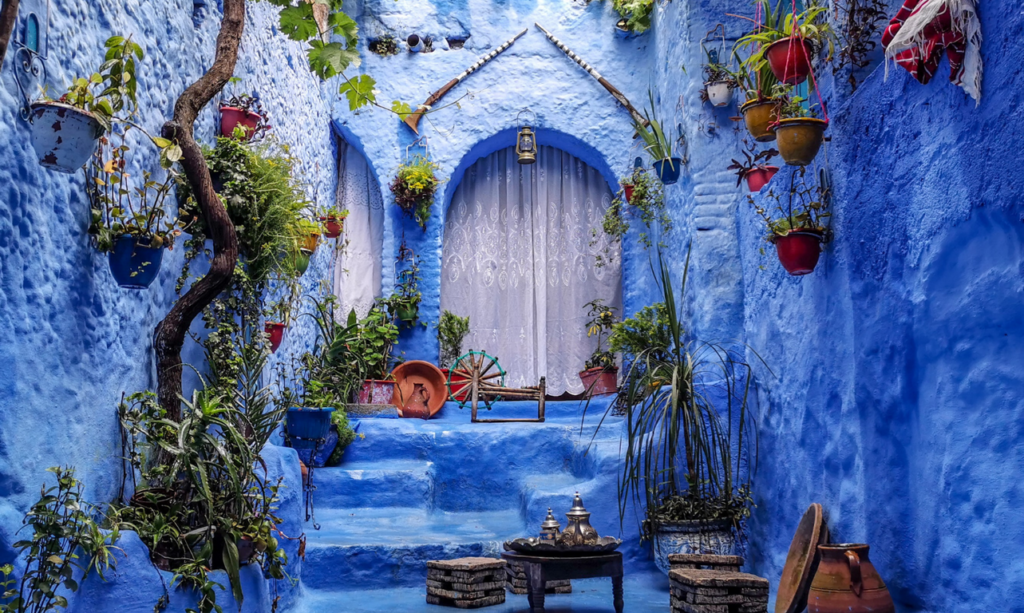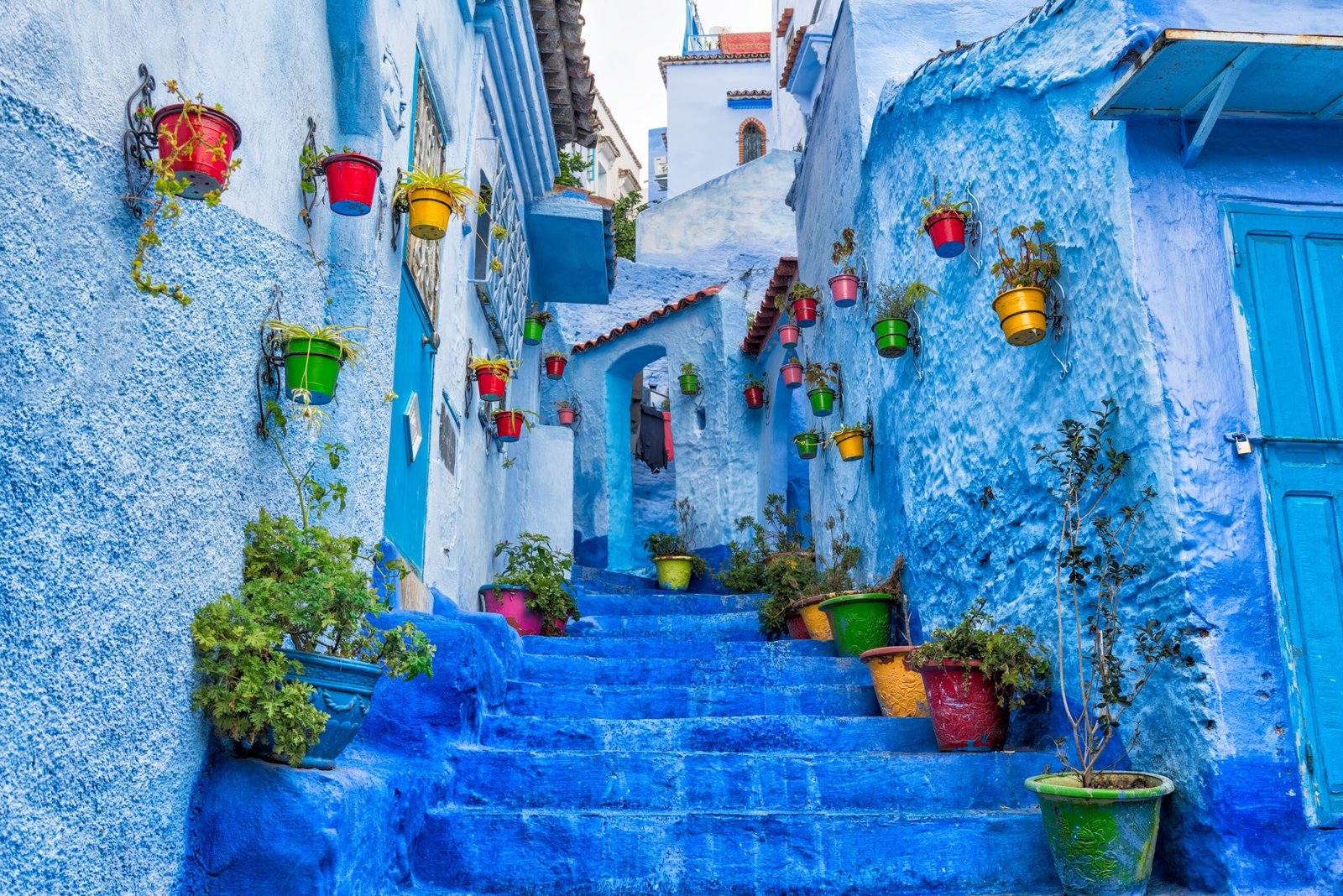A big trip, but one of the best from Tangier, is a visit to Chefchaouen – the Blue Pearl of Morocco, a beautiful and tranquil town in the Rif Mountains.
The Blue City.
And when I say blue, I mean blue.
The old medina has the trimmings and bottom 2 meters of its walls painted blue – some streets are entirely blue, including the street itself. It isn’t just pretty. This little town is breathtaking – a photographic paradise. Before I first visited I didn’t really believe it would be so blue, or that there would be more than a couple of streets of blue. But the whole medina is blue to the point of reflecting back on itself.
So here are TEN fun facts about Chefchaouen.
How blue is Chefchaouen really? It is breathtakingly blue!
In the medina all the buildings are painted blue to head height, but many streets even the whole wall is painted blue, sometimes the entire street itself, to the point that the blue reflects on itself. Everywhere you turn is a different shade of Blue, another photo-scene.
Every two years they have a festival and everyone is out in the streets repainting the blue to maintain the colour and keep it looking fresh.
Add in some lush green plants and cats. It’s a photographic paradise!

Nobody actually knows.
Well, most people think they know, and will proudly tell their story, but since there are so many different stories, I’ve realized – nobody really knows.
Some say that the blue is reminiscent of the Mediterranean Sea – though Chefchaouen is not actually on the coast. I’d have expected green for the hillsides, or red-yellow for the amazing sunsets.
The blue keeps the mosquitos away… I’ll leave that one for further scientific analysis.
Blue makes you feel cooler in summer. While true, this doesn’t seem to be a likely reason or I’d expect a load of blue cities around Morocco.
The theory that I like best is that the Jewish residents of the medina painted the walls in blue to remind themselves of God’s power. They weave thread, died with tekhelel (a natural blue dye) into their prayer shawls for this reason. They may have also painted the walls blue in Chefchaouen for the same reason, since a large number of the original inhabitants were Jews.
However, it may just be that they noticed tourists liking their streets this way, and there is nothing deeper in the reason than that. Perhaps sometimes the legend is better.
Any which way, Chefchaouen is now the blue city, and makes a very pretty visit. There is no question that the blue medina is beautiful to walk through.
What was that about sunsets in Chefchaouen?
Nestled in the Rif mountains, Chefchaouen has some spectacular sunsets. The best spot to watch the sunset is from one of the many rooftop cafes and restaurants around the main square. Sit with a glass of sweet mint tea, maybe also some biscuits and cakes, and chill with some friends and the magnificent sunset views.

What does Chefchaouen mean?
Chefchaouen is an Amazigh word. The Amazigh (or Berbers) are the original peoples of the area spread across several countries in this north western corner of Africa. ‘Chaoua’ means goat’s horns. And ‘chef’ means look at, so Chefchaouen means ‘Watch the horns’, in reference to the shape of the hills above the medina which looks like two horns.
Why is Chefchaouen’s main square called Place Outae Hammam – isn’t a hammam a traditional bath? You are quite right. The first hammam in Chefchaouen was in the square in the centre of town, logically – because that made it central to everyone. Originally the central square was a crossroads, but over time its function has shifted to tourism. Sadly, this hammam styled after the hammams of Granada or Cordoba was de-prioritized. But that does not mean to overlook it – find yourself a hammam and treat yourself to a Moroccan style bath while you are here.
What else should I see in Chefchaouen?
The oldest mosque is in Place Outae Hammam. Historically the most important mosque, the Grand Mosque of Chefchaouen was naturally located in the central square in the middle of the medina, near the kasbah (fortified castle).
What are Chefchaouen’s origins?
Chefchaouen was established as a military outpost by the Spanish in 1471 at the end of the Spanish Reconquista. Originally a small kasbah or castle fortress, it was built to defend against invasions of northern Morocco by the Portuguese. Its early residents were Muslim and Jewish immigrants who fled from Spain at the time, and later also Christian exiles, and still later for Jewish refugees again.
The kasbah was built in the Andalusian style and included the residence of the emir, horse stables and sheds, a garden, a prison, a small mosque, and several towers. It was built from limestone and rammed earth, with locally fired red bricks for the archways and features, with fir and juniper wooden platforms for the red tiled roof.
Chefchaouen was under Spanish control again from the 1920s to 1956.

What handcrafts and local products can I buy in Chefchaouen?
Chefchaouen is noted for its woven items and textiles, especially rugs, blankets and djellabas – the traditional long robes with pointed hoods. Many are produced by a blind co-operative which is available for viewing. Other products famous in Chefchaouen include goat cheese. Another fun fact – it is also the top region in Morocco for growing cannabis and hemp products. Many of the lush green hillsides around the town are in fact covered in cannabis plants.
What should I eat in Chefchaouen?
There are some excellent tajines in Chefchaouen. My favorite was the lamb and prune tajine. There is also chicken and apricot and some other combinations. The Clock Café has great rooftop views, and can sometimes include on its menu camel burgers.
When in season, try the cactus juice. The fruit can also be found with street vendors peeled and ready to eat so you avoid the problem of the prickles. Pomegranate or grenada juice, and of course freshly squeezed orange or lemon juice. And don’t forget – the Moroccan biscuits and mint tea which taste best at sunset on one of Chefchaouen’s rooftops.
Can I walk to the Ras Al-Maa mountain spring?
Yes. It is a good half day hike, though beautiful and worth spending the whole day. You find the spring by heading up to the top of the town, then following the river on up the hill. Chefchaouen is 660 m (2165 feet) above sea level in the northern Rif Mountains. Besides the rich flora, you can see lots of green and cork oaks, Atlas cedars and the Moroccan fir trees.
As well as a lovely walk and a nice swim in summer, it is the water supply for the town – the houses, hammams, fountains and gardens. If you look around you can find water mills for grinding up olives and grains. You can even spot women chatting over their washing at communal washing areas which were built by the UN – thoughtfully to reduce immigration to the EU by improving things in Morocco.
What is the best way to get to Chefchaouen?
Transport in Morocco depends on where you are. Going north to south from Tangier there are trains – the al Boraq to Casablanca is a top-class train and a very nice ride, making local connections to Fes and Meknes, and Marrakech. In the remote south there are only buses. But overall, your best way of traveling East-West is by the grand taxis.
From Tangier, ask a blue petite share taxi to take you to the Chefchaouen taxi station. From there the taxis will go as soon as they fill up, not usually a very long wait for the 6 or 7 people, maybe 10 or 20 minutes. If you are in a hurry you can always pay for the empty seats – the fare is a standard 70 dirhams per person to Chefchaouen.
The taxis are faster, more convenient and more comfortable than the buses, and take a bit over 2 hours. You can be back in your hotel in Tangier in the evening ready for another chill day in Tangier, perhaps enjoying a food event with Blue Door Cuisine making your own lamb tajine.
Written by Zallee Pepper.
Check out more blogs and misadventures by
OzzyHopper.com



